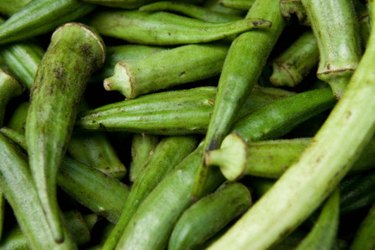 Okra originated near the Horn of Africa and was brought to the Americas by African slaves.
Okra originated near the Horn of Africa and was brought to the Americas by African slaves.
Okra, scientific name abelmoschus esculentus moench, is a member of the botanical Mallow family, which contains various plants and fruits like the marshmallow and the durian. Most of these species are indigenous to various parts of Africa and are often used for medicinal and culinary purposes. Okra is perhaps best known as an ingredient in gumbo.
Video of the Day
Mucilage
The most distinctive feature of the edible seed pod of this flowering plant is a thick and slimy mucilage, called so because it resembles mucus. Alternative medicine practitioners believe that this slime aids in digestion, and cooks take advantage of this property to thicken stews like the slow cooking creole dish gumbo.
Culinary Use
Many cooks try different techniques to get rid of this slimy property. In gumbo, the pieces are sliced so thin and cook so long that this mucilage is thoroughly incorporated in the stew. In saute or frying applications, the slices can be cooked with some acidic ingredient like lemon juice, vinegar or tomatoes. For this reason, whole okra also makes excellent pickles.
Growing
Okra thrives in warm weather, so it grows year-round in subtropical areas like Central Africa and the American South. In other areas, the planting season is from May to August; it bears fruit in about 60 days. When the seed pods mature, they must be harvested or they'll become fibrous and bitter.
Physical Characteristics
Okra pods have a distinctive lantern shape and are sometimes called "lady's fingers." They grow between 3 and 7 inches and have a light fuzz on the surface of the pod. The pods are produced from flowers, and each flower produces one pod. Like many fruits and vegetables, they are best harvested when medium-sized.
























